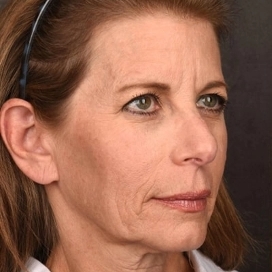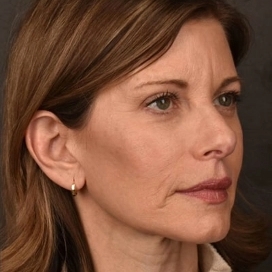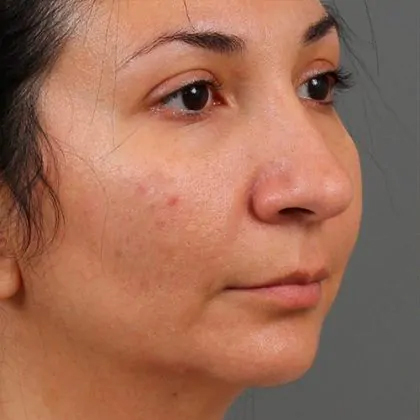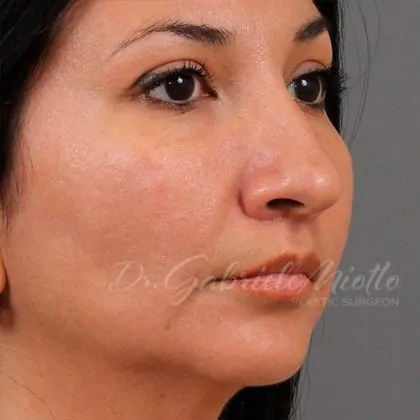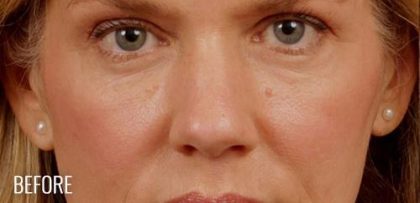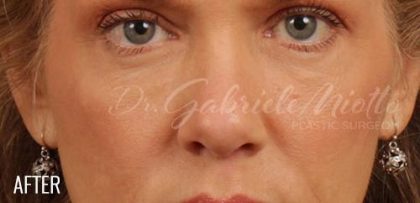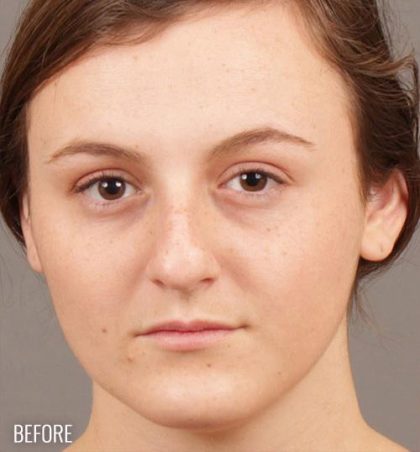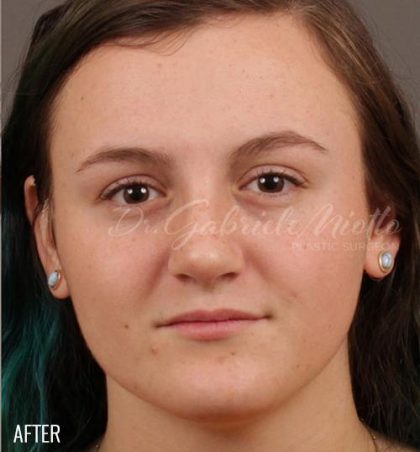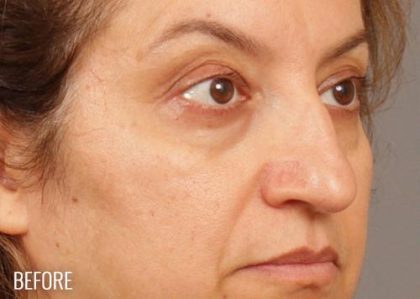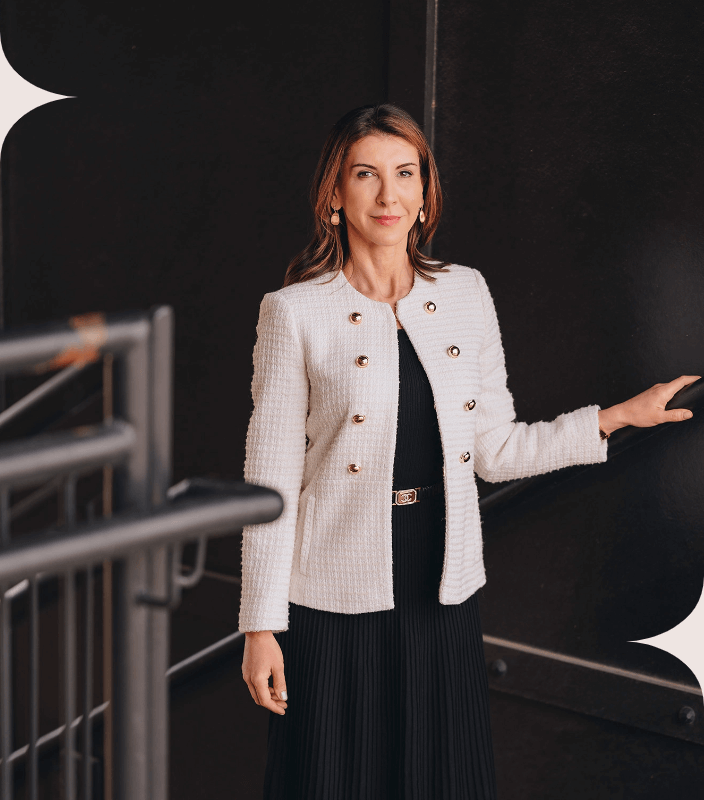Rhinoplasty
Conveniently located to serve the areas of Atlanta, GA

Rhinoplasty is one of the most popular procedures in plastic surgery. A surgical nose job can make a real and lasting change to one’s appearance, from increasing facial symmetry to rejuvenating the face.
Rhinoplasty is ideal for men and women who are bothered by the appearance of the nose. It can be a wide nose they would like to see thinner, a bulbous nose they would like to see smaller, or a crooked nose that needs to be straightened for aesthetic or functional issues. The droopy tip or a crooked nose are also indications for a rhinoplasty to better balance the face, and also improve breathing and nasal function.
Rhinoplasty surgery is done on an outpatient basis, has quick healing times and long-lasting results.
Dr. Gabriele Miotto, Atlanta Plastic Surgeon
Contents
- 1 Before and After Photos
- 2 Patient story
- 3 After the procedure
- 4 General preoperative recommendations
- 5 General postoperative recommendations
- 6 Activity
- 7 Bathing
- 8 Returning to work
- 9 Diet
- 10 Final results
- 11 Specialists
- 12 Candidate
- 13 How does nose surgery help with chronic breathing problems?
- 14 What is the difference between a septoplasty and a rhinoplasty?
- 15 Personalized rhinoplasty surgical plan
- 16 What to expect
- 17 Anesthesia is administered
- 18 Open Rhinoplasty Overview
- 19 Closed Rhinoplasty Overview
- 20 Multiple Procedures in One Session
- 21 Cartilage and Bone Reshaping
- 22 How long is the recovery process after a rhinoplasty in atlanta?
- 23 Recovery expectations
- 24 Restrictions and recommendations
- 25 Diet
- 26 Results
- 27 Preparing for surgery
- 28 How long do the results achieved with a rhinoplasty last?
- 29 Initial consultation
- 30 Rhinoplasty Risks
- 31 Is there a nonsurgical option that can provide the same results as cosmetic nose surgery?
- 32 What does cosmetic nose surgery typically cost?
- 33 FAQ
- 33.1 What is a rhinoplasty?
- 33.2 Am i a good candidate for rhinoplasty?
- 33.3 How is a rhinoplasty surgery performed?
- 33.4 Will a rhinoplasty help me breathe better?
- 33.5 Do I need to be sedated during rhinoplasty to the face?
- 33.6 Does rhinoplasty hurt?
- 33.7 How long does a rhinoplasty last? is a nose job permanent?
- 33.8 Is there a non-surgical option for a nose job?
- 33.9 Will there be a visible rhinoplasty scar after surgery?
- 33.10 Will there be swelling after rhinoplasty surgery?
- 33.11 What is the rhinoplasty surgery recovery time?
- 33.12 How much does rhinoplasty cost?
- 33.13 How can I get started to learn more?
- 33.14 When can I return to work after my rhinoplasty?
- 33.15 Will I be able to breathe through my nose after surgery?
- 33.16 Will I have a cast? if so, how long will the cast remain on my nose?
- 33.17 When will I see the final results?
- 33.18 Does it hurt after the procedure?
Before and After Photos
Patient story
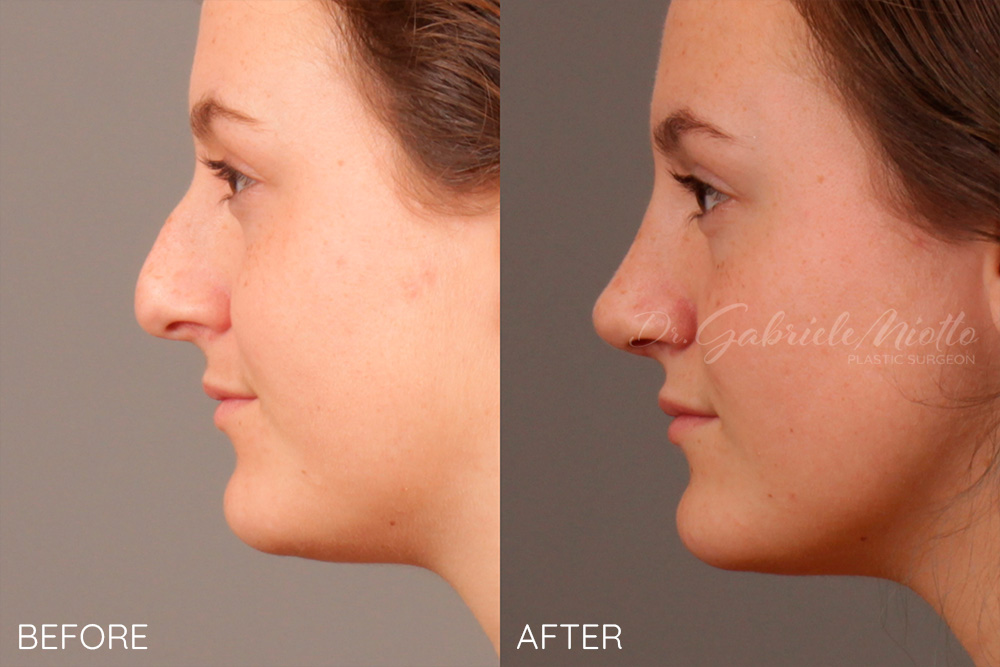
This is a female patient in her late 20’s who wanted to improve the wide and droopy nasal tip and the dorsal hump. She also had a septal deviation with breathing problems. We performed an open septorhinoplasty with correction of the septal deviation, reshaping of the tip and dorsum and elevation of the tip. Her profile looks much more balanced and she is breathing very well.
After the procedure

After the procedure, there will be some bruising and swelling. Swelling can be minimal or more intense depending on how many procedures need to be done to make the results the most beautiful and natural possible. Frequently combined procedures with a rhinoplasty are fat grafting to the face, liposuction, facelift, breast augmentation. There are many options for us to achieve the comprehensive aesthetic results.
Return to normal daily activities between 1-2 weeks. Expect at least 8 weeks for committing to major social events as residual swelling can remain for some patients after surgery. We are all different, so it is hard to predict who will get more or less swelling and bruising.
General preoperative recommendations
What to avoid before
- DO NOT take any aspirin for 7-10 days before your scheduled procedure. Do not take NSAIDS (Aleve, Motrin, Ibuprofen) for 5 days before surgery. You may take Tylenol (Acetaminophen) if needed for aches or pains. Please contact the office at if you have any questions about any medications that you are taking or if you are prescribed aspirin by your cardiologist or Primary Care Provider (PCP).
- Discontinue Vitamin E 10 days before surgery.
- Avoid the following herbal supplements for 10 days before surgery: Echinacea, Ephedra / Phentermine (used for weight loss), Feverfew, Fish Oils, Garlic, Ginkgo Biloba, Goldenseal, Kava-Kava, Licorice, Saw Palmetto, St. John’s Wort and Valerian.
- Stop Smoking. The harmful effects of smoking can cause tissue death, infection, and open wounds. It also makes you age faster!
- Alcohol can promote swelling of the surgical area and it is best to avoid alcohol intake for at least one week before surgery.
What to take before surgery
- Dr Miotto recommends some supplements before and after the procedures to speed up recovery during the office consultation.
General postoperative recommendations
- You need a responsible adult to take you home, we will not allow you to drive or be home alone immediately after surgery.
- You will be unable to drive if you are taking narcotics.
- It is recommended to elevate the head with two to three pillows after all facial procedures.
- Do not submerge the face and nasal cast for a week after the procedure (until the cast is removed)
- Rinse the nose with nasal saline 3-4 times a day to keep the area clean
Activity
- We require that you have a responsible adult stay with you for twenty-four hours after your surgery for general help, as you may find your balance and judgement impaired.
- Please refrain from intense physical activity that will increase your heart rate or blood pressure for 2 weeks after surgery.
Bathing
- You can shower twenty-four hours after surgery. You may clean the incisions as instructed by Dr Miotto or her nurses after the procedure.
- Do not scrub the surgical sites, however you can allow soapy water to run over them.
Returning to work
- Recovery time will vary; usually the swelling and bruising are visible for 1-2 weeks after surgery.
Diet
- Immediately following surgery, it is best to eat bland, easily-digested food and avoid excess sugar and salt. Healthy proteins (eggs, lean meat, beans, nuts), rice, fruits and cooked vegetables (broccoli, peppers, sweet potatoes) will provide your body with nutrients essential for healing.
- Eat a few bites of food before taking pain medications as these can cause nausea.
- A diet low in sodium will help minimize swelling and water retention.
- Drink plenty of water! Drinking low sugar sports drinks and protein shakes are recommended.
Final results
- Keep in mind that our goal in aesthetic surgery is improvement and not perfection. You will be followed closely after surgery to assure that you heal well and have the best possible results.
- It can take months for the very final results of your surgery be apparent. After 8-12 weeks, you can expect your results to be mostly permanent. Expect subtle changes in swelling and healing (including the appearance of scarring) to continue to improve for up to six to twelve months.
- It is important for you to keep open communication with your physician and return for your follow up visits. We will take pre and post pictures along the way and look at the final results together.
Dr. Gabriele C. Miotto is a Brazillian-American plastic surgeon specialized in aesthetic surgery and minimally invasive procedures, specially of the face, eyes, nose, breast and liposuction. Call (404) 850-5851 for your consultation.
Specialists
A rhinoplasty, which is also referred to as cosmetic nose surgery or a nose job, is a surgical procedure that is used to alter the shape of a patient’s nose. This procedure is extremely popular because the results are permanent and provide balance and harmony to patient’s faces. Nose surgery may also be performed to improve the patient’s ability to breathe. This procedure is referred to as a septoplasty. A combination of cosmetic and functional nose job is called a septorhinoplasty. At ME Plastic Surgery in Atlanta, Dr. Gabriele Miotto performs cosmetic and functional nose surgery to enhance a patient’s nose aesthetics and breathing. Cosmetic nose surgery is also performed to correct birth defects and repair nose deformities resulting from an injury.
Candidate
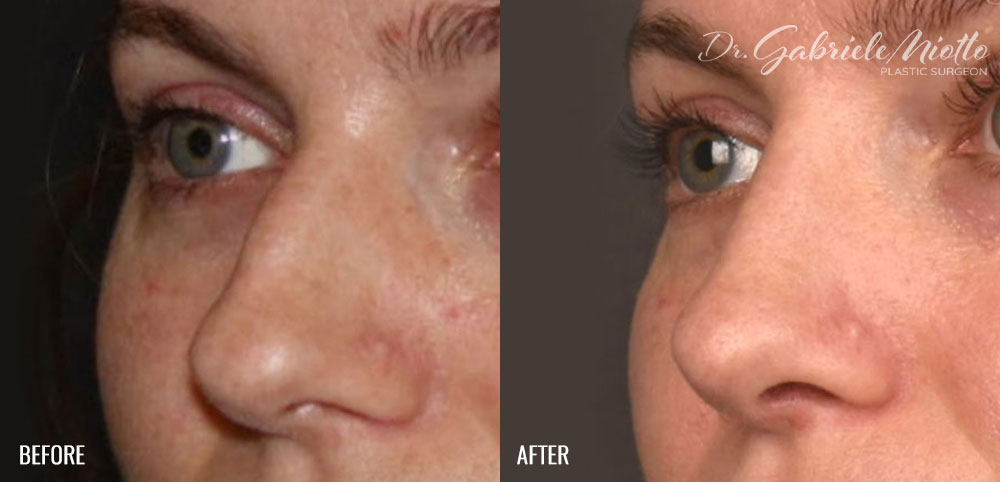
The ideal candidate for nose surgery is an individual who would like to change the appearance of his or her nose. Some of the most common aesthetic reasons people decide to have nose surgery include to straighten the bridge of the nose, address a crooked nose, decrease the size of a bulbous nose, raise a droopy tip or make a wide nose thinner.
People also choose to have a rhinoplasty with a septoplasty to address a functional problem, such as difficulty breathing due to a deviated septum or to improve the nasal function overall.
How does nose surgery help with chronic breathing problems?
When an individual has chronic breathing problems due to septal deviation or swollen turbinates, Dr. Miotto can address these issues during a combination septorhinoplasty at ME Plastic Surgery in Atlanta.
The turbinates are the bone and tissue structures located on each side of the nose. These structures are responsible for moistening and cleansing the air as we breathe in. If the turbinates become inflamed, which is a common issue when an individual has chronic allergies, the flow of air into the nostrils decreases. This interference in airflow makes it difficult to breathe.
At ME Plastic Surgery, enlarged inferior turbinates are addressed with functional nose surgery or this procedure is added to cosmetic nose surgery.
What is the difference between a septoplasty and a rhinoplasty?
Whereas cosmetic nose surgery is performed to address aesthetic issues, a septoplasty is a surgical procedure designed to straighten the wall inside the nose, which is referred to as the nasal septum.
If the septum is crooked, breathing can be negatively affected. At ME Plastic Surgery, a septoplasty can be performed at the same time as cosmetic nose surgery. It is common to use the removed septum to create grafts of cartilage to structure the nose and improve the nose aesthetics.
Patients who only want to correct a deviated septum can have a septoplasty without adding a cosmetic nose surgery.
Personalized rhinoplasty surgical plan
At ME Plastic Surgery, Dr. Gabriele Miotto creates each nose surgery patient a custom-designed surgical plan. Each plan is created taking the patient’s unique facial features into consideration.
Since every nose surgery is customized for a specific patient, outlining an ordered series of surgical steps is not feasible.
The upper section of the bridge of the nose is bone and the lower section is cartilage. While performing cosmetic nose surgery, the surgeon can change the cartilage, bone, skin or all three.
During cosmetic nose surgery, Dr. Miotto can change the shape, size or proportions of the patient’s nose.
What to expect
This procedure can last from 2 to 4 hours. Patients who choose to have multiple procedures during the same surgical session will spend more time in the operating room than those who just have cosmetic nose surgery.
Anesthesia is administered
While performing septoplasty and cosmetic nose surgery procedures, patient safety and comfort are the most important factors. As such, every rhinoplasty is performed with the patient under general anesthesia. Using general anesthesia secures the patient’s airway and ensures the he or she remains asleep throughout the procedure.
At me plastic surgery in atlanta, surgeons perform open and closed cosmetic nose surgery
Dr. Gabriele Miotto can perform an open or a closed rhinoplasty. Open nose surgery is used to address more complex issues and deformities, whereas, a closed rhinoplasty is the approach used when the problems a patient is experiencing relates more to the nasal tip.
Open Rhinoplasty Overview
Open cosmetic nose surgery exposes more of the nose and septum than closed nose surgery does.
A small incision is created externally at the base of the nose in the area between the nostrils, which is referred to as the columella. Another small incision is created just inside the nose. These incisions allow Dr. Miotto to access the cartilage and bone inside the nose.
Through this opening, the surgeons can modify and reshape any area of cartilage and bone. Once fully healed, the incision created during open nose surgery is nearly undetectable.
Closed Rhinoplasty Overview
When performing closed nose surgery, all incisions are created inside the nose.
Multiple Procedures in One Session
When cosmetic nose surgery is performed to lift the nasal tip and reshape the nose, the patient’s face looks more balanced, which can help the face appear more youthful, to enhance these results, many patients choose to have facial rejuvenation procedures at the same time as their cosmetic nose surgery.
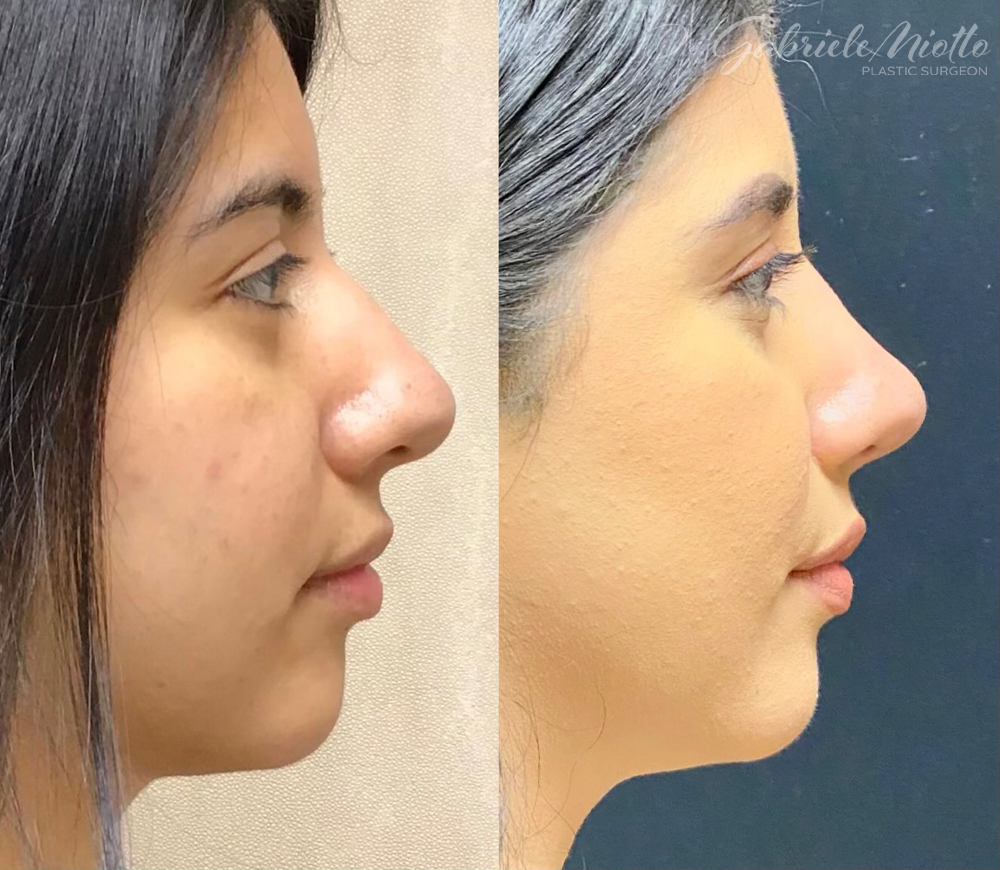
Atlanta Rhinoplasty (Nose Job) Before and After Photo. Surgery performed in Atlanta, GA by Dr. Miotto
A rhinoplasty and septoplasty can be performed during the same surgical sessions as some of the other plastic surgery procedures that are available at me plastic surgery in atlanta, including
- A facelift
- Facial contouring procedures
- Fat grafting
- Eyelid surgery
- Liposuction
- Breast augmentation
Cartilage and Bone Reshaping
Changing the structure of the nose requires the removal or the addition of cartilage, or bone. If the surgeon needs material to add to the patient’s nose, a cartilage graft can be used. It is the amount of material required that determines the area from which it is harvested.
For small changes, cartilage may be harvested from the ear or from the septum inside the nose. When the changes being made require more material, the surgeon may use cartilage from the rib, or use a freeze-dried human cartilage.
Once the surgery is complete, the patient remains in the recovery room for some time. When the patient is fully awake, he or she is released to the designated driver.
How long is the recovery process after a rhinoplasty in atlanta?
In general, the recovery time following surgery to change the structure of the nose or a septoplasty lasts a week or two, therefore, patients should plan to take at least 7 days off work or school.
Recovery expectations
After cosmetic nose surgery, patients will experience some swelling and bruising.
Whether swelling is minimal or intense depends on the number of procedures performed during the surgical session.
Swelling usually lasts from 7 to 10 days but can last up to 3 weeks.
Visible bruising can also last up to 3 weeks.
Since every person is unique, predicting the amount of swelling and bruising a patient will experience is difficult.
Patients generally return to their usual daily activities within a week or two.
To ensure all residual swelling has time to resolve, patients should avoid committing to major social events for at least 8 weeks.
Patients may use light-weight ice packs on their eye area and cheeks intermittently for the first 72h of surgery to help reduce inflammation. Crushed small ice packs are the best.
After surgery, to reduce inflammation and bleeding, patients need to keep their head raised higher than their chest. This can be accomplished with two or three extra pillows.
Patients should expect their nose to be congested. This congestion may be due to swelling or because thin splints were placed during surgery.
Internal splint, when necessary, stays in place for up to 7 days.
The external splint that is taped to the nose for support and protection typically remains in place for 7 days as well.
Restrictions and recommendations
Patients taking narcotics are unable to drive until off this medication.
To reduce the likelihood of experiencing nausea, patients should eat something before taking their medication.
The patient should not submerge his or her face until the surgeon removes the nasal cast, which usually takes place 7 days after the rhinoplasty.
Patients need to gently rinse their nose using nasal saline 3 or 4 times a day. This keeps the area clean, which reduces the likelihood of infection.
Patients must not sniff, blow, wipe, rub or blot their nose for 14 days.
Dr. Gabriele Miotto requires their rhinoplasty patients have a responsible adult that they trust remain with them for at least 24 hours after their procedure. Balance issues may happen following general anesthesia, this caregiver must be able to help the patient walk. Impaired judgement is also likely, which is why patients need to choose someone that they feel comfortable with and fully trust.
Patients must refrain from participating in any activity (e.g., jogging, aerobics, etc.) that will increase their blood pressure or heart rate for 14 days after their procedure.
They must avoid making extreme facial expressions (e.g., laughing, smiling, etc.) for at least 3 weeks after surgery.
Until the patient’s splint and bandages are removed, he or she needs to bathe instead of shower.
It is vital to limit the movement of the upper lip. Patients may want to avoid using an electric toothbrush for a few weeks after surgery and, while brushing with a manual toothbrush, patients need to be very gentle.
Avoid constipation by eating foods that are high in fiber. Fruits and vegetables are a good option; however, patients need to cut them up into small pieces to limit movement of the upper lip.
For at least 4 weeks after their rhinoplasty, patients must avoid resting sunglasses or eyeglasses on their nose. To continue wearing their glasses during this time, patients can use tape to secure the glasses on their forehead or use cheek rests.
Do not wear anything that needs to be pulled over the head, instead choose clothing that fastens in the front.
Once the bandages and splint are removed, it is vital that patients use sunscreen with an SPF of at least 30 while outside. If the skin of the nose is unprotected and then exposed to UV light, it may become discolored. This irregular discoloration can be permanent.
The follow-up appointment is extremely important because Dr. Miotto makes sure that the patient is healing as expected.
Diet
Directly following their rhinoplasty, patients should eat a bland diet that can easily be digested. Avoiding excess sugar and salt is recommended. Eating a diet high in salt can cause the patient to retain water, resulting in more inflammation.
Drink fresh water, protein shakes and sports drinks that are low in sugar.
Eat healthy proteins, cooked vegetables, rice and fruits. These foods provide the body with the nutrients it needs to heal.
Healthy proteins to consider include
- Lean meat
- Eggs
- Beans
- Nuts
Cooked vegetables to choose include
- Peppers
- Sweet potatoes
- Broccoli
- Cauliflower
- Carrots
Results
Patients need to keep in mind that the overall goal with cosmetic surgery is improvement, not necessarily perfection.
ME Plastic Surgery’s patients are closely followed to make sure that their healing process is moving along as anticipated.
For the most part, patients can expect their results to be permanent once they reach the 24-week mark after their cosmetic nose surgery. However, even after this time, patients may still experience subtle changes, including improved swelling and continued healing. The appearance of the nose and the external scar (if applicable) continues to improve for up to 12 months.
During the recovery process, patients are encouraged to openly communicate with their surgeon.
At ME Plastic Surgery, pictures are taken throughout the healing process to document the patient’s changes. Once healing is complete, these photos are compared to one another, allowing the patient and the surgeon to review the final results together.
Preparing for surgery
The preparation process before surgery is very important. What the patient does beforehand can make recovery easier as well as improve his or her overall healing process.
Before surgery, patients should
- Stop taking medications that contain aspirin or NSAIDS for at least 7 days before surgery.
- Contact ME Plastic Surgery at (404) 850-5851 if he or she has any questions about other medications. Patients who are taking aspirin because it is prescribed to them by their Primary Care Provider (PCP) or Cardiologist should also contact the office.
- Avoid taking NSAIDs (e.g., Motrin, ibuprofen, etc.) for 5 days before the rhinoplasty. Acetaminophen can be used in place of these other medications.
- Avoid these herbal supplements for at least 10 days before the procedure: Feverfew, Garlic, Echinacea, Phentermine/Ephedra (the weight loss drug), Ginkgo Biloba, Fish Oils, Licorice, Kava-Kava, Valerian, St. John’s Wort and Saw Palmetto.
- Do not take Vitamin E for 10 days.
- Stop smoking for at least 4 weeks before and 4 weeks after surgery. Smoking slows the healing process, which could result in open wounds, infection and even tissue death. In addition, smoking speeds up the aging process.
- Since alcohol is known to promote inflammation, patients need to avoid alcoholic beverages for at least 7 days before their rhinoplasty.
What patients should do before their nose surgery
- Dr. Gabriele Miotto will recommend certain supplements for her patients to take before and after their procedure. The supplements she recommends can help the patient recover faster.
- Patients should fill any prescription medications they need at least 2 days before their nose surgery as well as purchase Q-tips, hydrogen peroxide, 4×4” gauze squares and a roll of ½” paper tape.
- Purchase acceptable foods for after surgery. These foods should include white bread, crackers, light foods and broth-based soups.
- Ask someone they trust to drive them to and from their surgery.
- Ask someone they feel comfortable with and trust to stay with them for at least 24 hours after their nose surgery.
- After having anesthesia, patients may experience memory lapses, impaired judgement and slowed reaction time, which is why having a caregiver is so important.
- Be sure to notify Dr. Miotto of any sickness (e.g., flu, cold, etc.) that occur within 2 weeks of surgery.
How long do the results achieved with a rhinoplasty last?
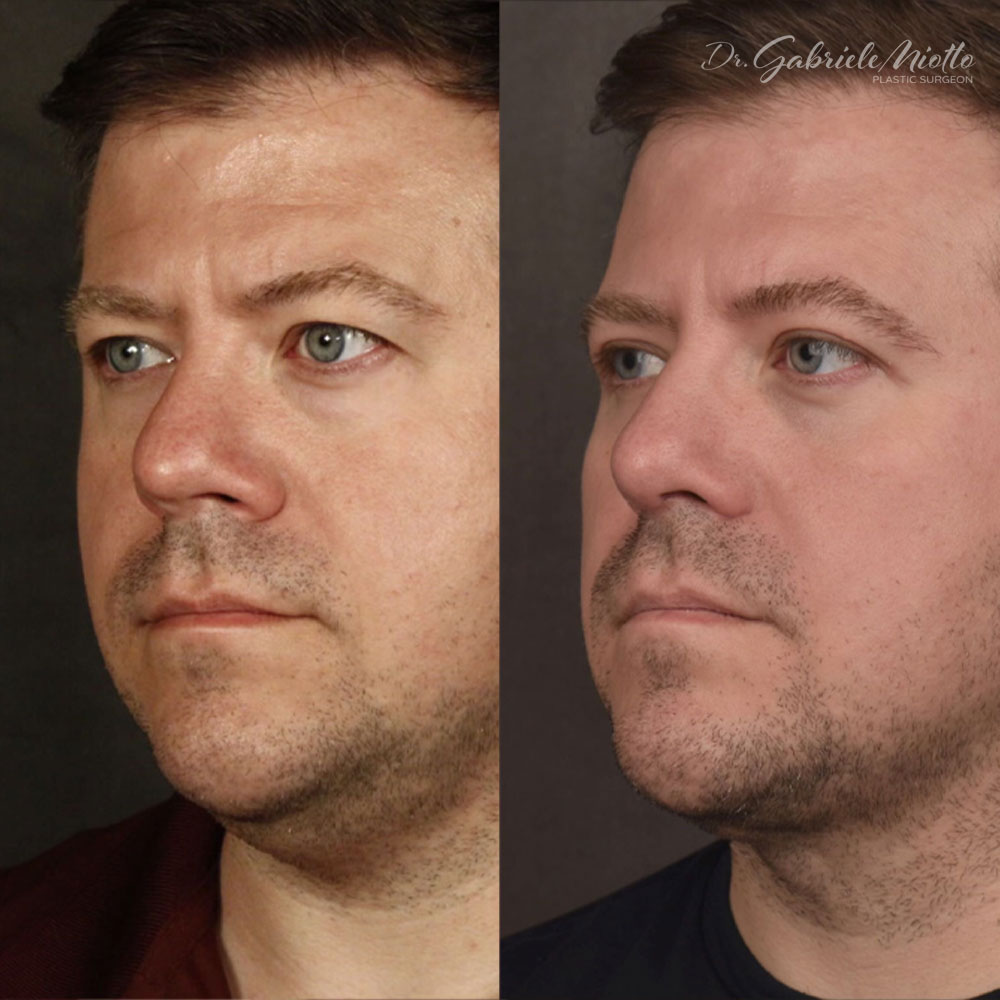
The results achieved with nose surgery are permanent. Therefore, as long as the patient does not experience a nose or a facial injury, the results will last indefinitely. That said, as part of the natural aging process, the skin of the nose thins. This thinning can cause small changes in the shape of the nose.
Overall, the average revision rate for cosmetic nose surgery is about 10 percent. These revisions are typically performed after the patient reaches 12 months post-op. At ME Plastic Surgery in Atlanta, most patients are pleased with their results, without the need for a revision.
Initial consultation
Dr. Gabriele Miotto is always happy to answer questions, so patients are encouraged to ask about cosmetic nose surgery, or any of the other procedures they would like to know more about, during this consultation.
What to expect during the first consultation at me plastic surgery
- The surgeon wants to know about the patient’s medical history, including any issues related to difficulty breathing through the nose. In addition, patients should be prepared to discuss what they would like to accomplish with nose surgery.
- A physical exam is performed. This exam may include the surgeon ordering laboratory tests.
- During this consultation, the surgeon performs a full facial and nasal examination. This examination includes the surgeon looking inside the nose.
- Patients who may be good candidates for nose surgery may get to see simulations as to what their nose may look like after a rhinoplasty in Atlanta.
- Photos may be taken. These photographs are taken from different angles and are used while creating the patient’s personalized surgical plan. In addition, these photos can be used for comparison purposes after surgery.
- Patients who have a small chin may want to consider having a chin augmentation during the same surgical procedure.
Rhinoplasty Risks
Every surgery has risks, however, as long as this procedure is performed by an experienced plastic surgeon, the risks of nose surgery are minor and complications associated with this procedure are rare.
At ME Plastic Surgery, patients are informed of the risks and benefits associated with nose surgery before they have the procedure.
Potential risks
- A reaction to the anesthesia used during surgery
- Infection
- Bleeding
Possible risks that relate specifically to nose surgery include
- Persistent inflammation, pain or discoloration
- Trouble breathing through the nose
- Septal perforation
- An uneven-looking result
- Permanent nose numbness (in and around)
- Visible scarring
- The need for another surgery
Is there a nonsurgical option that can provide the same results as cosmetic nose surgery?
Some patients can reach their goals with a liquid rhinoplasty, which is accomplished using dermal fillers. The results attained with dermal fillers last approximately a year. Dr Miotto is an expert injector and performs non-surgical rhinoplasties routinely. A non-surgical rhinoplasty can be done for patients who never had nose surgery, or for revision of a previous rhinoplasty to correct irregularities.
A liquid rhinoplasty can be used to address mild to moderate aesthetic issues. Once the results diminish, this procedure can be repeated.
What does cosmetic nose surgery typically cost?
At ME Plastic Surgery, nose surgeries are custom-designed for each patient, therefore, the only way that Dr. Gabriele Miotto can determine how much a patient’s surgery will cost is with an initial consultation.
If you are in the Atlanta area and you are interested in the cosmetic treatments or plastic surgery procedures that are available at ME Plastic Surgery, including the rhinoplasty procedure, contact the office today at (404) 850-5851.
Dr. Gabriele Miotto is dedicated to providing each patient with personalized, high-quality care. ME Plastic Surgery is located at 3200 Downwood Circle, Northwest, Suite 640 in Atlanta.
FAQ
What is a rhinoplasty?
Rhinoplasty is a common cosmetic surgery procedure, often referred to as a nose job. A rhinoplasty or a nose job treats aesthetic (the looks) and functional (the breathing) problems of the nose. It also improves facial proportions and overall facial balance.
Am i a good candidate for rhinoplasty?
You are a good candidate for surgical rhinoplasty if you would like to permanently change the look of your nose, improve the overall balance of your face, or if you are experiencing chronic breathing problems related to a deviated septum and nasal obstruction.
How is a rhinoplasty surgery performed?
The procedure is performed with either an open or a closed approach. In an open approach, we proceed with a much fuller exposure of the nose and the septum and we can treat more difficult deformities. We start with a little incision near the columella, the skin area between the two nostrils, and another small cut inside of the nose. This allows us to go in, reshape and modify all areas of the bone structure and cartilage. The open incision heals really well and is virtually imperceptible.
The other method of a rhinoplasty we perform is known as a closed approach. Here, there will be no columella incisions made, but only incisions inside the nose. We reserve a closed rhinoplasty for patients with isolated problems of the nasal tip and small problems of the dorsum. I perform both approaches depending on the problem of the patient.
A rhinoplasty can also be performed at the same time with other procedures of the face such as a facelift, eyelid surgery, or facial contouring. A rhinoplasty also rejuvenates the face by lifting the nasal tip and reshaping the nose, bringing more balance to the face.
Will a rhinoplasty help me breathe better?
If there are chronic breathing issues, we can make the nose breathe better by addressing the septal deviation or the inferior turbinate, and at the same time make the nose look better. The turbinates are bone and tissue structures on either side of the nose which aid in cleansing and moistening the air we breathe. When these structures become swollen and inflamed, as with chronic allergies, it can interfere with the flow of air and make breathing uncomfortable. Large inferior turbinates can be corrected during a functional rhinoplasty, or as part of a cosmetic rhinoplasty.
Rhinoplasty versus septoplasty.
A cosmetic rhinoplasty is performed to improve the aesthetics of the nose and to improve facial balance. A septoplasty can be part of an aesthetic rhinoplasty if there are certain breathing problems. A septoplasty can also be done in isolation, without changing the nasal aesthetics, specifically to correct a deviated septum.
Do I need to be sedated during rhinoplasty to the face?
All rhinoplasties are done under general anesthesia to secure the airway, patient comfort and safety during the procedure.
Does rhinoplasty hurt?
Patients may feel pressure from swelling after a rhinoplasty, and some mild pain after the surgery, which is treated with pain killers and NSAIDS.
How long does a rhinoplasty last? is a nose job permanent?
Yes, a rhinoplasty is a permanent change. The results will last as long as no other injury happens to the nose or face. However, as we age and the nose skin gets thinner, there may be small changes to the nasal shape. There is an average of minor revisions after rhinoplasty of about 10%. That is usually carried out after a year of the initial procedure if needed. Most patients enjoy beautiful result for years with no need for revision.
Is there a non-surgical option for a nose job?
The most common alternative to a surgical nose job are injections of fillers to reshape the nose, also known as a liquid rhinoplasty. A liquid rhinoplasty can achieve beautiful changes to the nasal shape, which are temporary and can last for about a year. This is a very common procedure performed for mild to moderate aesthetic nasal improvement and nasal shaping, and it can be repeated as needed.
If there are breathing problems, surgery by a skilled plastic surgeon is the only appropriate method to correct those issues. Products, such as nasal sprays, may help momentarily, but without a reduction of the enlarged inferior turbinates, or the treatment of an obstructing deviated septum or collapsed internal or external nasal valve, they may have any real breathing improvement.
Will there be a visible rhinoplasty scar after surgery?
No, the rhinoplasty incisions are very small and done in hidden areas in the nose. The open incision heals very well and is virtually imperceptible.
Will there be swelling after rhinoplasty surgery?
Yes, there will be some bruising and swelling after the surgery for about a week to 10 days.
What is the rhinoplasty surgery recovery time?
Recovery time depends upon which technique is used, and whether you have to have a septoplasty or structuring of the nose. The procedure itself lasts from 2-4 hours on average. The downtime is about 1-2 weeks after surgery. Some patients have more swelling or bruising than others, so it may take about 3 weeks for the most visible signs of surgery to be gone. We recommend 1-2 weeks off of work.
How much does rhinoplasty cost?
There are several factors which make up the cost of a rhinoplasty. It varies depending on the goals of the patient, the complexity of the procedure, and if the surgery includes both aesthetic and functional improvements.
How can I get started to learn more?
If you think you might be a good candidate for a rhinoplasty, we can meet at my office for an examination and even do some simulations to see what your nose might look like after surgery. I can show you several before and after photos of my patients, and we can talk more about the results you are looking for. Rhinoplasty is a wonderful and life changing surgery and I look forward to seeing you soon.
When can I return to work after my rhinoplasty?
So after a rhinoplasty, patients can go back to school or to work, usually a week afterwards. The first week after a rhinoplasty, we have sutures and we have a cast on top of the nose, sometimes inside of the nose, and the patients get bruised, sometimes a little bit of swelling, so I would recommend that the patients take five to seven days off and then go back to normal activities once we remove the cast and the sutures, which happens at seven days after surgery.
Will I be able to breathe through my nose after surgery?
All patients that undergo a rhinoplasty can breathe through the nose after the surgery. However, there is swelling that happens over the next 24 to 48 hours, and for some patients, that causes a stuffed up nose, so is a little more difficult to breathe. When we do also, a septal work, like a septoplasty, or we work on the inferior turbinates to improve the airflow, we do leave an internal splint that it’s a silicone splint, it does have a little hole in the middle so patients can breathe through it, it’s just a little harder. But once we remove that at seven days, the patients breathe really well. So most patients breathe well, some of them have a lot of swelling, so that causes a little bit of obstruction. But usually a week after surgery is really good.
Will I have a cast? if so, how long will the cast remain on my nose?
So after a rhinoplasty, most patients have a cast on the nose, if we need to treat the bony part of the nose. So usually when there is a dorsal hump or that bump on top of the nose, we need to shave that bone down, sometimes we need to create little cuts on the bone to make it narrower or to make it straighter. So when we do that, we have to use the cast on the nose so everything heals exactly how we wanted, the way we left after surgery. Otherwise, things can shift around, and that’s not a good thing for the outcome. So usually that stays for seven days after the procedure.
When will I see the final results?
So a rhinoplasty is a procedure that can have a lot of… generate a lot of swelling in the nose. So after surgery, after the seven days with the cast and the tape, you’re going to be able to see the results already at that point. But there is this lingering swelling that stays there for six months to a year. So usually we’d say that a rhinoplasty can… the nose can be swollen up to a year, depending on the technique that was used, if we needed to use grafts or if it was a secondary rhinoplasty with more scar tissue, but I tell the patients that a rhinoplasty result is actually done at about a year or a little bit, sometimes a little bit longer than a year. So never look at your results and either have a little bit of swelling, a little bit of hardness of the nose at six months, but that improves up to a year.
Does it hurt after the procedure?
Usually, a rhinoplasty is not a painful procedure, the patients don’t feel a lot of discomfort and pain. Patients feel pressure in the nose, almost like if you had a sinus infection or a cold because every area around the nose, like the sinuses, gets a little bit swollen around that and that creates pressure in the face. Some patients may have a headache as well, but it’s not very common to have… it’s not a painful procedure, you don’t feel the cuts or the incisions in the nose. And most patients feel really well just with anti-inflammatories and acetaminophen. Very few patients need to take narcotics or strong pain pills. So I would say that it’s not very disomfortable and the pain level is mild.
